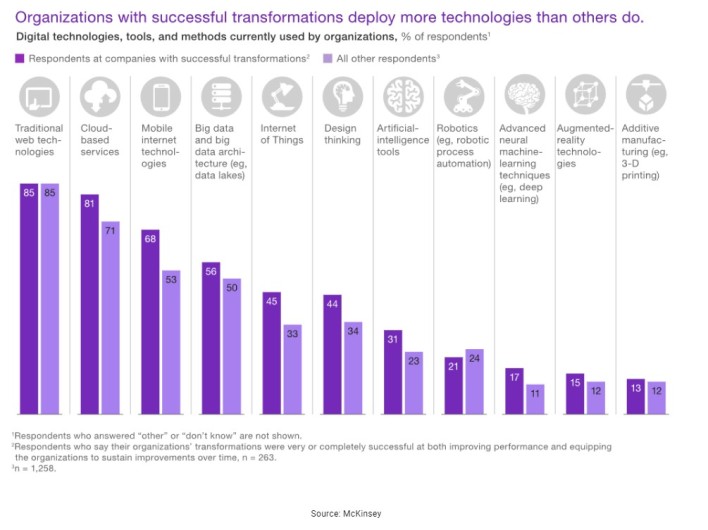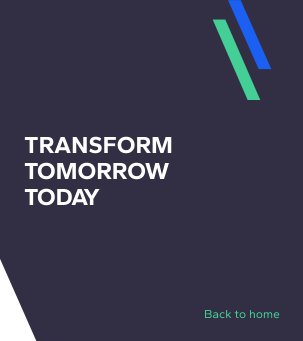Blog / Leadership & Transformation
Digital Transformation Strategy: 5 Success Stories in Retail
Categories

Adapt or die.
There’s no other strategy to remain competitive in the digital era.
But how to actually do that?
And what does it look like?
While we are certain that digital initiatives will improve operational efficiency and drive growth, it’s always better to look at real-world examples for some inspiration. It doesn’t matter if you’re a big company or a small business, or a motivated entrepreneur with future tech plans: these stories of successful digital transformation will give you relevant insights and takeaways to thrive in the digital economy.
Digital Transformation Strategy: Walmart
Investing (a lot!) in technology. Walmart has gained some fame when it comes to telling digital transformation success stories. There’s hardly an article on the topic that doesn’t mention them, and there’s a reason for that. In fact, the numbers speak for themselves: During the 2018 fiscal year, Walmart spent a total of 11.7 billion in technology investment, which made it the third-largest IT spender in the entire world behind Amazon and Alphabet.
Building up a robust tech team. 1,700 technology employees were hired in 2018 and 2,000 more jobs were to be added to its nine tech centers by the end of 2019. On top of that, Walmart appointed a new CTO and CDO: Suresh Kumar, a former Amazon’s vice president of worldwide retail systems and most recently Google’s vice president and general manager of display, video, app ads and analytics.
Adopting a holistic approach to digitalization. All that indicates that it’s not about re-platforming e-commerce business anymore, it’s about re-platforming across the board and deploying transformation strategy across all aspects of the business from supply chain management and delivery to the overall customer experience.
Using technology to improve operations: shelf scanning robots & electronic shelf labels. For shelf inventory Walmart uses shelf scanning robots that are able to identify which stock keeping unit is in its slot and the price that goes with it This helps to avoid poor inventory performance that leads to lost sales and increases the accuracy rate of demand forecast. Plus, with electronic shelf labels price adjustments can be done automatically.
Understanding transitions: Offering a range of checkout options. Walmart has tested cashierless technology in various stores, as well as Mobile scan and go systems. But Kumar noted that not all customers want to use them, so they combine cashierless tech with cashiers.
Having a space (literally!) to explore digital solutions. Walmart’s Intelligent Retail Lab (or “IRL”; located in NY) is a fully operating store with an AI lab. It covers over 30,000 items across 50,000 square feet and is full of sensors, camaras and processors (Walmart’s execs say they are connected by enough cabling to scale Mt. Everest five times!) that monitor product inventory and availability. This is the place to discover, learn, and execute AI solutions. Some examples: automatically trigger out-of-stock notifications to internal apps that alert associates when to restock; apps that make sure shopping carts are available and that monitor cash register lines.
Embracing and extending Blockchain technologies. We have already written about Walmart in the context of blockchain success cases, where in partnership with IBM, they are urging the suppliers to track the produce using this technology to guarantee food. Now the company is considering blockchain in other areas, “as a mechanism to be able to automate the transactions between suppliers, carriers, and logistics”, explained Kumar at Walmart’s 2021 KeyBanc Technology Leadership Forum.
Considering & Investigating Voice Technology. A successful digital transformation strategy requires people to be constantly on the lookout for relevant tech trends, and that's the case with Voice. This is another area of interest and a "very natural extension" of reducing customer friction, according to Kumar. "I think over a period of time, the most natural way in which you are going to interact with a system that's out there, including for shopping, is going to be through voice," he stated in the Conference.
Exploring disruptive technologies of the future. Virtual try-ons, which Walmart already offers for clothes, could also apply to home and outdoor goods with the use of augmented and virtual reality, Kumar said. “Let's say, you're trying to buy a tent ... You don't want to actually buy it and try to set it up and then find out that it's not working for you," he explained. Walmart also counts on Walmart Labs, the technology division responsible for its global e-Commerce initiatives, that focuses on data analytics and technology to make shopping faster and better (and that produced high-quality websites and apps for Walmart and Sam’s Club like Vudu and Oneops). Walmart has set bar high for all the retailers, putting time, energy, resources and talent behind developing technology and integrating that with the core business practice. It is not just a competitive advantage for retailers. It’s a requirement.
Digital Transformation Strategy: Target
Using strong leadership to spearhead a digital transformation strategy. In 2014, this American department store chain brought on a new CIO, Mike McNamara, who had previously served as Tesco’s CIO in Europe. He completely restructured Target’s IT workforce, streamlined its priorities, adopted more agile ways of working, and invested in modern digital platforms. He focused on strengthening Target’s in-house capabilities (the company now has about 4,500 technologists and data scientists across the U.S. and India): “Technology was and is too important to outsource: it plays an enormous role in determining the winners of any industry,” he said in an interview. In 2014, 70% of the team was outsourced; in 2022, that number went down to 7%.
Investing in cloud architecture. “Today, Google takes most of our guest-facing traffic (...) We’ve actually created our own deployment platform, we call it TAP (Target Application Platform). And that allows us to push workloads into GCP or into our own data centers, or indeed, down into our own stores, of which we’ve got about 1900 across countries, and all our little mini data centers”, he explained in another interview. The company also bets on a hybrid cloud: “We can operate stable workloads much cheaper in our own data centers (...) But then for the elastic workloads, placing them where they are best needed is the true nature of hybrid cloud, whether that is our own data centers, it’s Azure, it’s GCP, it’s all of the edge”, he concluded in that talk.
Building an Omni-Channel Experience. In 2017, Target announced it would invest $7 billion to transform its supply chain along with its digital and in-store experiences. It was a fruitful move: Its store pickup and curbside pickup grew 70% and 600% in a year (2020), and its online sales reached$16 billion in that same period, as this article explains. Target’s nearly 1,900 stores were an integral part of its digital growth. Actually, 95% of all sales (in stores and online) were fulfilled from the chain’s physical stores. The company explained that Omnichannel customers (customers that purchase from stores, mobile and online) spend four-times more than store-only buyers on average, and 10-times more than digital-only customers.
Deploying useful services to improve the buyer journey. Target’s curbside pickup service, Drive Up, was launched in 2018 and has been vital to increase sales. Over the years, many technology enhancements have been added to it: A functionality to provide backup suggestions when an item is unavailable; a chainwide rollout of numbered parking spaces for shoppers; the ability to designate an alternate person to pickup an order, among others. Plus, the retailer has also added more Drive Up locations and is working on adding canopies to help with the weather.
Using technology to generate richer user experiences. Their engineers are now building on voice, AR, AI and VR to provide greater utility for their customers and integrate richer shopping experiences. The objective is to build a holistic digital strategy that offers deeper levels of personalization and engagement across every guest-facing part of their ecosystem.
Focusing on personalization and customer loyalty. The retailer's app offers a user-friendly and personalized shopping experience, and is also a source of insights on user preferences, behavior trends, and shopping habits. On the other hand, Target Circle, the company’s free loyalty program, is also a strong bet and has proven successful in retaining customers. It offers rewards 1% back on every purchase and 5% back when you shop on your birthday, among other perks.
Digital Transformation Strategy: Sephora
Merging the digital and the physical to meet customers where they are. When the Sephora team discovered that customers often use their personal smartphones to search independent product reviews or recommendations while in the physical store, they developed a mobile app designed to emulate the knowledge of a personal shopping assistant. The client can scan the product using the Sephora app for ratings and reviews but also for looking up past purchases, viewing her wish list or managing gift and loyalty cards. Later, they added a tool powered by augmented reality – Virtual Artist – so that customers can virtually try on makeup products. Color Match, an AI feature, assists the customers finding the right color shade for their skin tone via an uploaded photo. Sephora also has a Live Beauty Help feature on its mobile app and website. A customer using this feature is paired with a Sephora beauty advisor in real time who can answer questions such as “what foundation matches my skin tone?”or “is this shampoo OK for my curls?”
Exploring and investigating with in-house technology. The industry-leading chain of cosmetic stores has its own research laboratory in San Francisco that develops new products making use of augmented reality, artificial intelligence and RFID technology, among others.
Building 360-degree customer profiles. All in all, Sephora’s digital strategy is to provide the customers with tools to help them feel confident in making a purchase. Whether it’s in store or online doesn’t matter. This manifests in Sephora merging the digital and in-store teams to realign themselves to the profile of today’s multi-channel shopper. Combining the two teams, has permitted the company to build 360-degree customer profiles and trace customers’ precise offline and online behaviors.
Embracing innovation in mobile. The numbers speak for themselves: The Sephora to Go application is currently one of the top 25 retail offerings in the Shopping Category for Apple’s App Store. The app is full of interactive tools that allow users to experiment with the latest makeup trends and to share their beauty tips and tricks using instant social sharing buttons.
Prioritizing the use of data-driven technologies (AI/AR). Sephora uses a wide range of AI and AR Technologies: ‣NLP, ML and Computer Vision ‣Visual Artist (where customers can see designs on their facial avatars before they buy products) ‣Fragrance IQ System (Sephora has partnered with Inhalio to provide a dry scent for customers to smell the fragrance of perfume without trying it on) ‣Pantone Test (a system that determines the best product suggestions for different customers based on their preferences).
Partnering with strategic players of the digital ecosystem. Such as Replika, a social commerce company that helps the brand promote and sell products through social media. For example, through ambassador campaigns. This move is a good way to strengthen ecommerce, since it enables consumers, influencers, experts, beauty or shop assistants to sell brands and products on social platforms through formats such as live shopping or livestreaming
Digital Transformation Strategy: H&M
Fostering a culture of courage in the business. “This means to dare to do new things, to dare to fail, to try something outside the box, or things that you haven’t done before. At H&M we have always been very entrepreneurial. You have to tap into that and ensure that people dare do those changes”, explains Arti Zeighami, Global Head of Advanced Analytics & AI at H&M Group. A digital transformation strategy requires a digital mindset.
Investing in technological tools to improve customer experience. H&M started experimenting with mobile technologies to improve the buying experience. For example, it launched the Perfect Fit app (where customers can create their digital avatar based on selfies they took and use it to try on clothes while shopping online).The brand also has an image search function in their app, where customers are able to scan images and find similar clothes by H&M, as well as visual search that allows shoppers to upload a photo and use it to search for relevant items. Plus, the company is already exploring virtual try-ons: “By creating digital twins of our products, customers can try on clothes virtually,” said Frans Borgstrand, who is working with developing 3D technology at H&M Group.
Using digital tools to support sustainability. By 2025, H&M Group aims to have 100% of its brands’ products designed for circularity. For that purpose, in 2021 it launched an innovative circular design tool called “Circulator”. Its first part consists of a downloadable guide that invites stakeholders to "co-create and learn together". It is a four-step process: step one is to know the customer, step two to define the product's purpose category (either light, mid or extensive use), step three is to choose appropriate materials and step four is to select design strategies (such as for increased durability, non-durability, increase recyclability or waste avoidance). The feedback and learnings from this initial launch will then contribute to the development of the second part: a scoring tool. The brand is also exploring 3D technology to save material. In 2020, the design team at H&M used 3D technology and zero waste pattern cutting techniques in the making of the Zero Waste Dress. Recycled polyester was used to make the dress and instead of making several traditional prototypes before starting the production, the team adjusted color, shape and structure using 3D technology.
Investing in material innovation and recycling technology. One example is the Looop, a garment-to-garment recycling machine that the company has already installed in a Stockholm store. Another example is Renewcell, a company that H&M Group has invested in, that is developing a new material called Circulose, made by gently recovering cotton from worn-out clothes. H&M is also considering embedding technology into the products themselves: “Product ID will make it simple for consumers to swap, share, and show garments—and in terms of impact follow-up. Digital enablers will make it much simpler for garments to flow through circular business models such as resale, rental, and repair”, explained Vanessa Rothschild, H&M Group’s global sustainability steering and development manager.
Digital Transformation Strategy: Nike
An aggressive strategy to become a digital-first, direct-to-consumer (D2C) company. Mainly by two tactics: Consumer Direct Offense (CDO) and Consumer Direct Acceleration (CDA). CDO: the company has said goodbye to many partnerships (Macy’s, Urban Outfitters, Shoe Show, Dunham’s Sports, Dillard’s, Fred Meyer, Zappos, Amazon) and focused the majority of its efforts on D2C, leveraging on digital. CDO involves: accelerating innovation and product creation, growing operations in 12 key cities across ten countries, and deepening one-to-one connections with interactive experiences across different channels. CDA aims to develop a premium and seamless brand experience wherever customers shop: digital, online-to-offline services, as well as physical experiences through store concepts (Nike House of Innovation, Nike Rise, Nike Live, and Nike Unite). It also involves broadening the categories of Nike’s consumer constructs, going beyond runners or yoga practitioners and including men, women and kids categories with deeper product insights and greater specialization.
Heavy investment in Mobile Technology. That includes innovative features such as the Nike Fit feature of their app, for example, allows the customers to scan their feet and find a shoe that fits the best. It uses the customer’s smartphone camera to create an ultra-precise scan, which collects 13 points of data and builds a map of both feet. The same app is used to gather data to improve the design of future products.
Focus on collecting customer data. Nike has been aggressively recruiting in-house Data scientists and machine learning engineers to increase its capacity in data analytics and AI. It has also been involved in Startup acquisitions to gain competitiveness through the use of data. For example, it acquired a predictive analytics startup Celect, founded by MIT professors in 2013, to bolster its DTC strategy, a consumer data analytics firm Zodiac, and a computer-vision company Invertex to strengthen its artificial intelligence capabilities. Nike’s most recent acquisition is Datalogue, which it acquired in February 2021, which will help Nike integrate data from all sources.Plus, it is using data and analytics to deliver a better customer experience. The Nike app, for instance, provides users with access to the Nike+ rewards program, which offers personalized exclusives to members, early access to new products, priority access to events, and personalized workouts. And the Nike Training Club and Nike Run Club apps track workout and running statistics and provide users with audio guides during training sessions. "We look at our app ecosystem as really providing content, community, activity and connection for our consumers, even beyond the transaction," Heidi O'Neil, President of Nike Direct, told The Wall Street Journal.
The brand also utilizes this data to inform its physical retail location strategy: "It helps us pick our Nike-branded retail locations in places that can serve not just as stores but serve as hubs for our members and service centers," she said. "We also use data to select and curate the product in the stores. We'll know if a neighborhood or a market is really popular for running, training, or let's say sneaker culture. Then, of course, we use data to understand what's selling."
Using technology to monitor inventory. Technology success is at the core of Nike's strategy. For example, many Nike products are tagged with a RAIN RFID tag chip, allowing them to be tracked through the rest of their journey, from factory to warehouse to shipment to store. This provides real-time inventory data on product location, stock numbers, and more information. This information can be fed back into manufacturing for faster response to consumer demands, or used to quickly divert products to where they are more popular.
Betting on Headless Commerce. Customers no longer do most of their shopping on a traditional website. Instead, shopping takes place on mobile apps, IoT devices, and many other channels. Therefore, many companies are adopting a headless commerce strategy that aims to provide a seamless shopping experience for any channel there is or will emerge. How? With application programming interfaces (APIs), that connects “multiple heads” to the same backend. APIs use specified protocols to allow applications with different frameworks to communicate with each other. The good thing is that this enables scalable multi-channel commerce because all heads and sales channels are synchronized.
Strengthening the supply chain through IT. Key areas include: product design, production, forecasting, ordering, manufacturing, transportation, sales, distribution, and processing financial information for external and internal reporting purposes, retail operations, and other business activities. In manufacturing, for example, Nike uses Flyknit, a digitally engineered knitting process used to manufacture shoes that produce 60% less waste than traditional cut-and-sew methods. It also employs Flyprint, the world’s first 3D-printed textile upper in performance footwear. To increasing total fulfillment capacity, as another example, the company has developed more than 200 robots in collaboration with Geek+
A Holistic Digital Transformation Strategy impacts sales & performance
There you go: 5 digital transformation success stories that show how top companies embrace change and innovative thinking. Digital transformation is the way forward, and it's never too late to start your digital roadmap. As always, is the equilibrium of forces that will have the most impact: tools, processes, people and mindset. As the following graphs show, a successful digital transformation strategy is holistic and balanced:

There is no dobut that embracing innovation and nurturing a digital mindset will benefit your business in multiple ways. Digital transformation companies are leading the way. That's why at Zigurat we have developed a comprehensive training programme in our MBA that teaches executives how to deploy a successful digital transformation srategy in their businesses, covering all departments (Marketing, Sales, Purchasing, Logistics, Human Resources).
For that, we have assembled a stellar Faculty Board of top executives that have first-hand experience in every phase of the digital transformation process.
Are you interested in transforming all levels of your business?
Our Global MBA in Digital Business will foster your technological and decision-making skills and add a differential value to increase your competitiveness in the global market.





